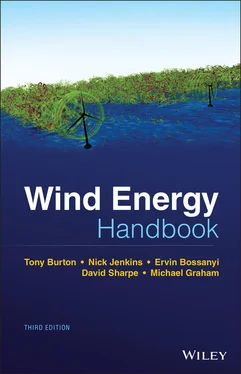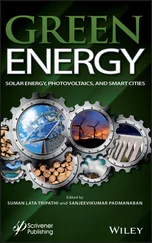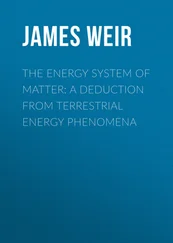6 Chapter 10Table 10.1 Typical breakdown of cost of an onshore wind farm (IRENA 2012).Table 10.2 Typical separation distances for medium sized wind turbines.Table 10.3 Agreements for the development of a wind farm using project financ...Table 10.4 Examples of sound pressure levels.Table 10.5 Centre frequency of octave bands and A‐weighting.Table 10.6 Sound power levels of mechanical noise of a 2 MW experimental wind...Table 10.7 Octave band sound power levels of a large wind turbine (Bowdler an...Table 10.8 Air absorption coefficient in octave bands (Danish Statutory Order...Table 10.9 Noise limits for sound pressure levels L Aeqin different European c...Table 10.10 Example of radar cross‐section of a wind turbine and wind farm.Table 10.11 Recommended ranges for assessment of primary surveillance radar.Table 10.12 Bird strikes at wind farms in the UK.
7 Chapter 11Table 11.1 Voltage levels of the power system.Table 11.2 Effects of various aspects of lighting on a wind turbine.Table 11.3 Wind turbine lightning damage frequency.Table 11.4 Measured earth impedance at substations of two wind farms.Table 11.5 Indication of possible connection of wind farms to distribution ne...Table 11.6 Ratio of site capacity to connection short‐circuit level for two l...Table 11.7 Examples of de‐rating factors used in GB.
8 Chapter 12Table 12.1 Indicative costs of a 1 GW offshore wind farm (BVG Associates 2019...Table 12.2 Future projections of capacity factor and LCOE from wind farms.Table 12.3 Ultimate load cases during operation.Table 12.4 Ultimate non‐operational load cases.Table 12.5 Fatigue load cases.Table 12.6 Surface roughnesses (from DNVGL‐RP‐C205 2017).Table 12.7 Support structure corrosion protection measures by zone.Table 12.8 Approximate weights of jacket structure, secondary elements, and p...Table 12.9 Turbine parameter values used to derive weight scaling factors at ...Table 12.10 Comparison of tripod and jacket structure weights at Alpha Ventus...Table 12.11 Selected dynamic analysis codes for floating offshore wind turbin...Table 12.12 Indicative mooring system loads for a 15 m diameter spar buoy wit...Table 12.13 Hywind Scotland spar buoy and wind turbine leading dimensions and...Table 12.14 Natural periods of Hywind spar buoy floating wind turbine (Hywind...Table 12.15 WindFloat Atlantic semi‐submersible and wind turbine leading dime...Table 12.16 Floatgen platform and wind turbine leading dimensions (Choisnet e...
1 f10 Figure C2 Fixed coordinate system for hub loads and deflections, and positio...
2 Chapter 1 Figure 1.1 Wind power capacity worldwide (World Wind Energy Association 2020... Figure 1.2 Wind power capacity by country (US Energy Information Administrat... Figure 1.3 Installed onshore wind power capacity in countries with more than... Figure 1.4 Onshore wind turbines in flat terrain. Figure 1.5 Offshore wind farm. Figure 1.6 Largest commercially available wind turbines.
3 Chapter 2 Figure 2.1 Wind spectrum from Brookhaven based on work by Van der Hoven (195... Figure 2.2 Example Weibull distributions Figure 2.3 The factor Γ(1 + 1/ k ) Figure 2.4 Turbulence intensities according to various standards Figure 2.5 Comparison of spectra at 12 m/s Figure 2.6 Comparison of spectra at 25 m/s Figure 2.7 Some asymptotic limits Figure 2.8 Gust factors calculated from Eq. (2.46) Figure 2.9 Illustration of the Gumbel method
4 Chapter 3 Figure 3.1 The energy extracting streamtube of a wind turbine. Figure 3.2 An energy extracting actuator disc and streamtube. Figure 3.3 Variation of C Pand C Twith axial induction factor a . Figure 3.4 The trajectory of an air particle passing through the rotor disc.... Figure 3.5 Tangential velocity grows across the disc thickness. Figure 3.6 Helical vortex wake shed by rotor with three blades each with uni... Figure 3.7 Simplified helical vortex wake ignoring wake expansion. Figure 3.8 The geometry of the vorticity in the cylinder surface. Figure 3.9 The radial and axial variation of axial velocity in the vicinity ... Figure 3.10 The axial variation of tangential velocity in the vicinity of an... Figure 3.11 The axial variation of tangential velocity in the vicinity of an... Figure 3.12 Flow field through an actuator disc for a = 1/3 . Figure 3.13 A blade element sweeps out an annular ring. Figure 3.14 Blade element velocities and forces: (a) velocities, and (b) for... Figure 3.15 Power coefficient – tip speed ratio performance curve. Figure 3.16 Comparison of theoretical and measured values of C T. Figure 3.17 Variation of blade geometry parameter with local speed ratio. Figure 3.18 Variation of inflow angle with local speed ratio. Figure 3.19 Optimum blade design for three blades and λ = 6: (a) blade ... Figure 3.20 Uniform taper blade design for optimal operation. Figure 3.21 Spanwise distribution of the lift coefficient required for the l... Figure 3.22 Spanwise distribution of the twist in degrees required for the l... Figure 3.23 Radial variation of the flow induction factors with and without ... Figure 3.24 Spanwise variation of the blade geometry parameter with and with... Figure 3.25 Variation of inflow angle with local speed ratio with and withou... Figure 3.26 The variation of maximum C Pwith design λ for various lift/... Figure 3.27 Helical trailing tip vortices of a horizontal axis turbine wake.... Figure 3.28 Azimuthal variation of a for various radial positions for a thre... Figure 3.29 Spanwise variation of the tip‐loss factor for a blade with unifo... Figure 3.30 Spanwise variation of power extraction in the presence of tip‐lo... Figure 3.31 A (discretised) helicoidal vortex sheet wake for a two bladed ro... Figure 3.32 Prandtl's wake‐disc model to account for tip‐losses. Figure 3.33 Comparison of Prandtl tip‐loss factor with that predicted by a v... Figure 3.34 Spanwise variation of blade circulation for a three blade turbin... Figure 3.35 Spanwise variation of combined tip/root loss factor for a three ... Figure 3.36 Axial flow factor variation with radius for a three blade turbin... Figure 3.37 Variation of blade geometry parameter with local speed ratio, wi... Figure 3.38 Variation of inflow angle with local speed ratio, with and witho... Figure 3.39 Spanwise variation of power extraction in the presence of tip‐lo... Figure 3.40 The variation of maximum C Pwith design λ for various lift/d... Figure 3.41 The variation of circulation along the length of a blade. Figure 3.42 Pressure measurements on the surface of a wind turbine blade whi... Figure 3.43 A comparison of measured and Snel's predicted power curves for a... Figure 3.44 The aerodynamic characteristics of the NACA632XX aerofoil series... Figure 3.45 Angle of attack distribution for a range of tip speed ratios. Figure 3.46 Distribution of the flow induction factors for a range of tip sp... Figure 3.47 Distribution of blade loads for a range of tip speed ratios (lin... Figure 3.48 Variation of thrust coefficient with tip speed ratio. Figure 3.49 Variation of the actual force with wind speed. Figure 3.50 C P ‐ λ performance curve for a modern three blade tur... Figure 3.51 C P ‐ λ performance curve for a modern three blade tur... Figure 3.52 Effect of changing solidity. Figure 3.53 The effect of solidity on torque. Figure 3.54 The effect of solidity on thrust. Figure 3.55 Non‐dimensional performance curves for constant‐speed operation.... Figure 3.56 Effect on extracted power of rotational speed. Figure 3.57 Effect on extracted power of rotational speed at low wind speeds... Figure 3.58 Effect on extracted power of blade pitch set angle. Figure 3.59 Pitching to feather power regulation requires large changes of p... Figure 3.60 Power vs wind speed curve from the binned measurements of a thre... Figure 3.61 Comparison of measured and theoretical performance curves. Figure 3.62 Measured raw results of a three blade wind turbine. Figure 3.63 C P ‐λ curve for a design tip speed ratio of 7 at 7 m/... Figure 3.64 K P ‐1/λ curve for a fixed‐speed, stall‐regulated turb... Figure 3.65 Power vs wind speed. Figure 3.66 Energy capture curve. Figure 3.67 Energy capture curve for numerical integration. Figure 3.68 Power vs wind speed for variable‐speed turbine. Figure 3.69 NREL aerofoil profiles for large blades. Figure 3.70 The Risø‐A series of aerofoil profiles. Figure 3.71 The Risø‐P series of aerofoil profiles. Figure 3.72 The Risø‐B series of aerofoil profiles. Figure 3.73 The Delft University series of aerofoil profiles. Figure 3.74 Flat‐back aerofoil derived from DU‐97‐W‐300. Figure 3.75 VGs on a blade suction surface. (Flow is from right to left.) Figure 3.76 Flaps and similar acting devices: (a) conventional trailing edge... Figure 3.77 Lift coefficient vs jet momentum coefficient for jet circulation... Figure 3.78 Low noise aerofoil family: (a) DTU‐LN1xx, (b) DTU‐LN2xx, and (c)... Figure 3.79 Diagram of serrated trailing edge for reduction of TE noise. Figure A3.1 Flow past a streamlined body. Figure A3.2 Boundary layer showing the velocity profile. Figure A3.3 Separation of a boundary layer. Figure A3.4 Separated flow past a flat plate. Figure A3.5 Laminar and turbulent boundary layers. Figure A3.6 Variation of C dwith Re for a long cylinder. Figure A3.7 Flow past a rotating cylinder. Figure A3.8 Circulatory flow round a rotating cylinder. Figure A3.9 Flow past an aerofoil at a small angle of attack: (a) inviscid f... Figure A3.10 The pressure distribution around the NACA0012 aerofoil at α ... Figure A3.11 The pressure distribution around the NACA0012 aerofoil at α ... Figure A3.12 Stalled flow around an aerofoil. Figure A3.13 C l − α curve for a symmetrical aerofoil. Figure A3.14 Variationof C dwith α for the NACA0012 aerofoil. Figure A3.15 Lift/drag ratio variation for the NACA0012 aerofoil. Figure A3.16 Variation of the drag coefficient with Reynolds number at low a... Figure A3.17 Variation of the drag and lift coefficients with Reynolds numbe... Figure A3.18 The profile of the NACA4412 aerofoil. Figure A3.19 Classification of the NACAXXXX aerofoil range. Figure A3.20 The characteristics of the NACA4412 aerofoil for Re = 1.5·10 ...
Читать дальше












